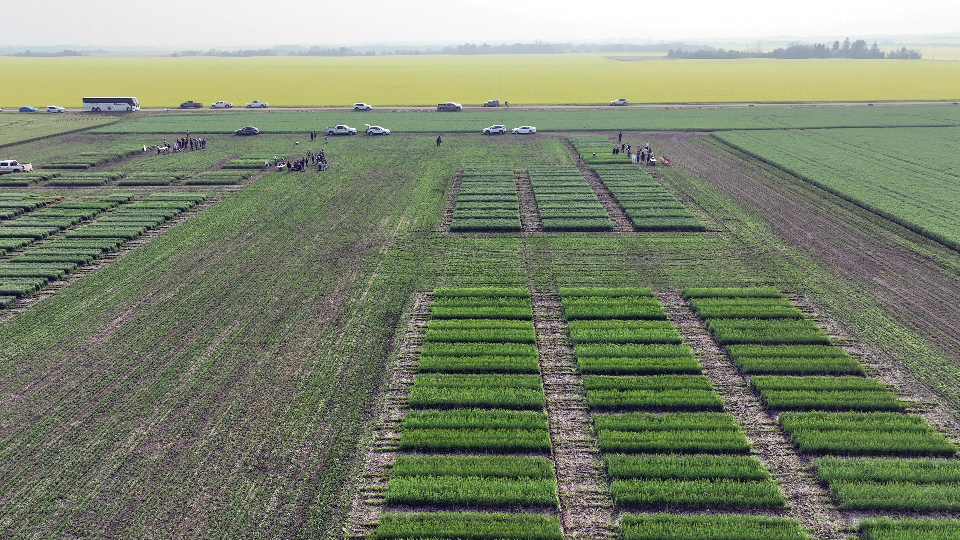STRAIGHT UP RESULTS
BY TIM PARENT • PHOTO COURTESY OF LAKELAND COLLEGE
Led by Lakeland College in partnership with Farming Smarter and SARDA Ag Research, a three-year study examined ways to minimize lodging and maximize yield in barley. The project was carried out with the support of the Agriculture Funding Consortium. The initiative, which wrapped up this year, examined the combined effects of cultivar selection, plant growth regulator (PGR) strategies and tank mixes under Prairie conditions.
“Lodging is a significant problem in feed barley. About 40 per cent yield reductions have been reported here in Western Canada due to lodging,” said Balwinder Kumar, cereal crops research scientist at Lakeland College. “The project was designed to identify effective plant growth regulator strategies that can reduce lodging and optimize grain yield.”
The study was carried out at Lakeland College in Vermilion, the Farming Smarter facility just east of Lethbridge and SARDA Ag Research in Falher. It tested three barley varieties: CDC Austenson, Esma and AB Hague under nine varied Moddus PGR treatments. These included single, split and tank-mix applications with herbicides or fungicides.
Across sites and years, researchers tracked plant height, lodging index, yield, grain quality and economic return. “All the PGR treatments reduced plant height,” said Kumar. A high dose of Moddus at the flag-leaf stage—the recommended rate for single application—was the most effective.
In lodging suppression, the most significant reductions occurred when Moddus was tank-mixed with fungicide at flag-leaf emergence or applied in split doses. Yield also responded positively. “Split application of Moddus at early tillering and stem elongation achieved a significant yield increase by nine bushels per acre,” said Kumar.
Varietal response mattered, too. Esma consistently performed well, often outyielding the others. “Esma didn’t need as much PGR support because it is already short-statured, which provides excellent lodging resistance,” noted Kumar. Decision should be made based on specific farm conditions, as high-yielding environments may warrant it, he added. “But the other two varieties benefited from PGR support in high-input systems.”
Tank mixing PGRs with fungicides or herbicides also delivered logistical and financial benefits. “Tank mixing eliminated extra spray passes, improving efficiency and saving $10 to $12 an acre,” said Kumar. “There were no compatibility issues or crop injury recorded.”
For Farming Smarter, the study’s value lay in the data and its practical demonstrations. “This study was a really good example of seeing basically a bar chart in the field,” said Mike Gretzinger, the organization’s agronomy manager. “At every field day, you could walk out and say, ‘That was obviously sprayed with PGR,’ and compare treatments side by side.”
The study highlighted the difficulty to recreate lodging in small-plot research as it occurs in the field. Even with high fertilizer rates and irrigation, trial plots did not always lodge as severely as expected. “Getting lodging in small plots is always a bit of a challenge,” said Gretzinger. “We had high fertilizer rates, irrigation and decent lodging at times, but it doesn’t always compare to a full farmer’s field conditions.”
The findings suggest while short varieties with a good stand such as Esma may offer a reliable option, farmers considering higher yielding but lodging-prone varieties should look closely at PGR strategies. Kumar emphasized that balanced fertility, especially with nitrogen and micronutrients such as zinc and copper, is also critical to reduce lodging risk.
Kumar and Gretzinger agreed the research will help farmers make better informed decisions. “Often in studies, we come up with treatments that make no sense in the real world but are required for statistical purposes,” said Gretzinger. “This was the opposite. The treatments were rooted in reasonable farmer strategies, and that’s what made it valuable.”







Comments